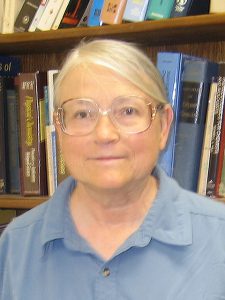(1946-2020)

Dr. Linda Kurz, emeritus research faculty member of our department, died on December 17, 2020, at home in rural Franklin County. She was 74.
Dr. Kurz worked with Drs. Carl Frieden and George Drysdale for many years, investigating enzyme mechanisms. She was true biochemist, as hard-core as they come. She retired a few years ago, and many of us overlapped with her for a substantial period of time. I believe she gets credit for the sign on the Frieden lab door saying “if we knew what we were doing, it wouldn’t be research.”
She raised Dobermans, and she often brought one or two into the lab on the weekend or at night (this was a different time). As a postdoc, Dr. Cooper would often walk between Elliot’s lab (now Janice’s space) and Carl’s lab; encountering a Doberman in the hallway by surprise usually induced a healthy surge of adrenaline, a miniature cardiac stress test.
You can read her obituary by clicking here.
Remembrances from colleagues
Peter Burgers
Linda truly was a hard-core biochemist. She and George Drysdale, who passed away a few years ago, ran a research lab together and she continued when George retired. Linda studied H/D kinetic isotope effects and fascinating enzyme mechanisms involving hydride tunneling. Citrate synthase was one of their favorite enzymes. Everybody walking on their side of McDonnell on the second floor knew her Dobermans. On Saturdays but sometimes also during the week. Most of the time, they laid under her desk. They looked really sweet and placid, but I don’t think that anybody had the courage to pet them. I certainly didn’t.
Tim Lohman
So sorry to hear this. Linda also taught for many years, out of the goodness of her heart, in our Biochemistry core course, the pre-cursor to Macromolecular Interactions.
I also had several Doberman encounters in the early days. I learned to round corners slowly.
Carl Frieden
Linda came to my lab in the early 70’s. I think her motivation was that our work at that time was studying enzymes that exhibited complex enzyme kinetics and she felt she could learn more about that in relation to enzyme mechanisms. As it turned out I believe I learned more from her than she from me. Her studies from the beginning focused on the mechanism of enzyme action from the point of view of a chemist using chemical techniques and quickly apparent became that she could carry out research on her own. Her approach was meticulous and thoughtful. She was quickly put on the research track and eventually was promoted to full professor. At one point Linda got interested in adenosine deaminase to serve as a mechanistic model for the more complex Amp deaminase that I had been studying. What she really became interested in, however, was the mechanism of citrate synthase and she and George Drysdale published several papers on this interesting enzyme.
Linda was successful in obtaining NIH grants. As Tim Lohman points out Linda, for many years, participated in teaching in the Biochemistry core course and did it willingly.
As for her dogs (Dobermans) that some mention they were actually trained as show dogs. She was transporting one of the in her car when suddenly the car stopped and rolled over in a ditch. The accident damaged her back extensively and I believe she never recovered from the accident. Her dedication to science and to enzyme mechanisms will be sorely missed.
